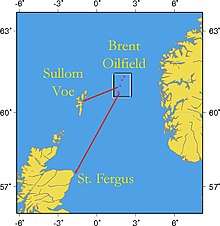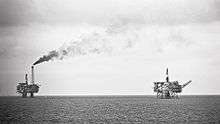Brent oilfield
The Brent field is an oil and gas field located in the East Shetland Basin of the North Sea, 186 kilometres (116 mi) north-east of Lerwick, Shetland Islands, Scotland, at the water depth of 140 metres (460 ft). The field operated by Shell UK Limited was once one of the most productive parts of the UK's offshore assets but has reached the stage where production is no longer economically viable. Decommissioning of the Brent field is ongoing and will be completed in the early 2020s. [1]
| Brent | |
|---|---|
 | |
| Country | Scotland, United Kingdom |
| Region | North Sea |
| Location | East Shetland Basin |
| Block | 211/29 |
| Offshore/onshore | Offshore |
| Coordinates | 60°54′N 1°48′E |
| Operator | Shell UK Limited |
| Partners | Royal Dutch Shell, ExxonMobil |
| Field history | |
| Discovery | 1971 |
| Start of production | 1976 |
| Production | |
| Producing formations | Brent Group |
Name
Shell initially named all of its UK oil fields after waterbirds in alphabetical order by discovery – Auk, Brent, Cormorant, Dunlin, Eider, Fulmar and so on. Brent refers to the brent goose, and in turn gave its initials to the geologic subdivisions of the Jurassic-age Brent Group that make up the field: Broom, Rannoch, Etive, Ness and Tarbert formations, with each name representing a loch in the Scottish Highlands).[2]
Geology
Situated in the East Shetland Basin, the Brent is the archetype for many of the fields in the area, consisting of a tilted fault block exposing the eponymous Brent formation, next to bounding faults which allowed migration from deeper adjacent "kitchen" areas where the Kimmeridge Clay Formation becomes fully mature and releases hydrocarbons. Unusually on a worldwide scale (but common in this basin), the seal or cap rock for the reservoir (which stops the hydrocarbons from migrating further towards the surface) is also the Kimmeridge Clay, or technically the Heather Formation immediately below.
The reservoir depth is 2,651 metres (8,698 ft).
Production

Production started-up on 11 November 1976, and on 13 December 1976 the first tanker was loaded. The Brent field oil is extracted by four platforms in an irregular SSW-NNE line.[3] The first in place was the concrete-legged "Condeep" Brent Bravo in 1975, followed by the concrete-legged Brent Delta, Brent Charlie, and steel-jacket Brent Alpha. As of 2004, the platform was still producing oil through a manifold (all Brent Alpha fluids are produced across to Brent Bravo). A fifth installation, the floating Brent Spar, served as a storage- and tanker-loading buoy and was installed early in the field's construction. The "spar" design of this installation led to the name by which it became the best known of the Brent installations (outside the oil industry). The field also included a remote flare, the "Brent Flare", which was used to flare off excess gas before gas handling and export facilities were installed in the field. This unit was decommissioned and removed using a heavy lifting barge in 2005.[4]
The topsides for Brent Charlie were designed by Matthew Hall Engineering which was awarded the contract in January 1974.[5] Initially there were facilities for 19 oil production wells, nine water injection wells, six gas injection wells and three spare slots. The production capacity was 150,000 barrels (24,000 m3) per day and 8.5 million standard cubic metres of gas per day. There were three production trains each with four stages of separation with the first stage separators operating at a pressure of 9.6 bar. The 14 subsea storage cells had a capacity of 400,000 barrels (64,000 m3). Electricity generation was powered by three 12 MW Rolls Royce Avon gas turbines. The topside accommodation was for 120 people. There were 14 topsides modules and the topsides weight was 34,000 tonnes.[5]
The field supplies oil via the Brent System pipeline to the terminal at Sullom Voe, while gas is piped through the FLAGS pipeline ashore at St Fergus on the north-east coast of Scotland.
The field underwent a £1.3 billion upgrade project in the mid 1990s, which involved depressurising the entire reservoir and making extensive modifications to three of the four Brent platforms. This converted them to low-pressure operation, which unlocked significant quantities of natural gas from the reservoir and extended the field life beyond 2010.[6]
See also
- Brent crude
- Energy policy of the United Kingdom
- Energy use and conservation in the United Kingdom
References
- "Brent Field Decommissioning". Shell UK. Retrieved 8 January 2015.
- Jack-2 and the Lower Tertiary of the Deepwater Gulf of Mexico
- "Talks start on turning off Brent". BBC News. 16 January 2007. Retrieved 5 June 2010.
- "Archived copy". Archived from the original on 11 May 2015. Retrieved 8 November 2012.CS1 maint: archived copy as title (link)
- Matthew Hall Engineering publicity brochure n.d. but c. 1990
- New drilling, completion technology critical to Brent redevelopment
| Wikimedia Commons has media related to Brent field. |